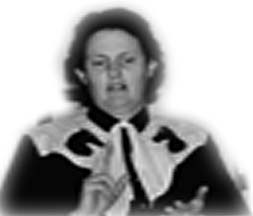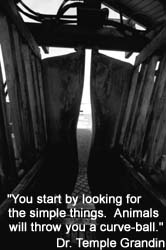 |
|||||||||
Seeing the World in Pictures |
|||||||||
| by: Kerri D. Howell | |||||||||
|
"Oprah," "20/20,"
"48 Hours" and "CNN’s Larry King Live." People
Magazine, the New York Times, Forbes and U.S. News and World Report. She
has been featured in all of them. No, she’s not a movie star, singer
or politician. She is Dr. Temple Grandin, an assistant professor of animal
science at Colorado State University. Grandin teaches courses on livestock
behavior and facility design. Is this why she is the talk
of the town? No. She is a designer of livestock-handling facilities. Approximately
half of the cattle in the United States are handled in a center-track
restraining system she designed. She has designed facilities in Canada,
Europe, Mexico, Australia, New Zealand and other countries. Is this why Grandin is in the
spotlight? We’re getting closer. Yes, she is a teacher. Yes, she
is an inventor. Yes, she is autistic. Grandin was diagnosed with
autism at two years of age. She credits this early intervention to helping
her overcome her handicap. Autism is a neurological disorder
caused, in most cases, by a complex inheritance of many interacting genetic
factors. People with autism have structural abnormalities in the brain.
It is a disorder in which some parts of the brain are underdeveloped and
other parts may be overdeveloped. This overdevelopment may be why some
autistic people have enhanced visual and savant skills, according to the
Center for the Study of Autism. Most autistic people have exceptional
visual spatial skills but poor verbal skills. Grandin says she thinks
in pictures. This means she has the ability to visualize and see the world
in picture-form. She translates both spoken and written words into, "full-color
movies, complete with sound, which run like a VCR tape," in her head,
according to Grandin’s book, "Thinking in Pictures." Grandin
credits her visualization abilities with helping her understand the animals
with which she works. Before attempting any construction
of her designs, Grandin can test-run the equipment in her imagination.
Grandin’s way of thinking is so accurate that she has had only one
design out of the many in her lifetime that did not work exactly the way
she had imagined. "Often, the best ideas
for inventing things come just as I am drifting off to sleep," Grandin
writes in a recent paper entitled "My Mind is a Web Browser."
"The pictures are clearer then. It is as though I can access the
most concrete, vivid memory files with the most detailed images."
Grandin says the language-part of her brain is completely shut off at
night, increasing the clarity of her "pictures." Grandin is also a specialist
in animal behavior. Her disorder gives her a special insight into the
mind of the animals. As a child, Grandin craved pressure stimulation at
certain points of her body. In attempts to gain this pressure, she would
crawl under the sofa cushions or wrap herself in blankets. As a teenager
Grandin watched cattle being branded in a squeeze chute at a relative’s
farm and noticed the immediate calming effect of the pressure administered
to the cattle in the chutes. After witnessing the effect
of the squeeze chute, the 18-year-old Grandin built her own squeeze chute
for humans, which is now commonly referred to in the autistic world as
the "Hug Machine." This machine provides deep pressure stimulation
evenly across the lateral parts of the body. Grandin still uses her "Hug
Machine" to give her the pressure needed to cope with her anxiety.
"You start by looking
for the simple things," Grandin said. She believes a major problem
in the feedlot industry is darkness. High contrasts of light and dark
frighten cattle. She calls this the "Cave Theory." "Ninety-nine percent of
cattle will go into a shoot without electric prods if it’s done right,"
Grandin said. Removing the common distractions that scare cattle will
change an entire operation. A piece of chain hanging too low in front
of cattle will keep an entire group from entering a facility. "Animals will throw you a curve-ball," Grandin said. "Animals notice the little details." Grandin says progressive people
in the industry — those with a vested interest in the cattle —
take notice of the little things. A number of Grandin’s past students
sing her praise after using her designs and following her principles. Grandin, now in her 40s, is
a champion for the autistic community. She has authored two books and
numerous papers regarding the disorder. Among the many issues raised
by Grandin is the issue of nurturing the talents of autistic children.
She says talents need to be fostered and broadened into useful things.
As a child Grandin’s artistic ability was encouraged by her mother.
She now uses this ability to design her inventions. Developing talents
in autistic children will provide an intellectually satisfying career.
Grandin believes her life would
not be worth living if she did not have her work. Her career is her life.
She says to make up for social deficits, autistic people need to make
themselves so good that they are recognized for brilliant work. Though Hollywood may interview Grandin due to her disorder, the livestock industry respects her for her knowledge. Dr. Temple Grandin, the professor, is working for the industry’s future. Dr. Temple Grandin, the designer of livestock handling facilities and equipment, is changing the way the world’s livestock industry operates. Dr. Temple Grandin, the autistic woman, is thinking in pictures and educating the world. |
|||||||||
 Grandin
has made various improvements to existing slaughter plants by simply knowing
how cattle think.
Grandin
has made various improvements to existing slaughter plants by simply knowing
how cattle think.